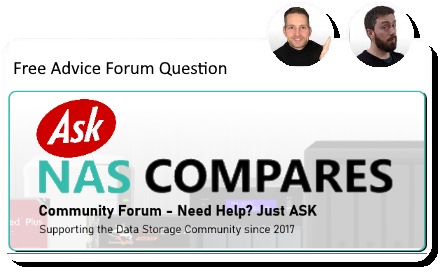Posts: 1,079
Threads: 1,080
Joined: Feb 2020
Reputation:
2
Hello there, i love your youtube channel. it helped me a lot in choosing my NAS. i did not find a video on how to secure data against ransomware attacks. (that might be an interesting toppic?) Could i get your advice on how to setup a backup system that ist safe against ransomware attacks? how much can i send you via paypal in return for your help? i have a Qnap TS-410E NAS with 2x 2TB SSD. My idea was to setup 2 volumes on one drive for my wifes and my time machine backup and then use the other drive to do a qudedupe backup of the time machine files. That way our data should be safe, even if a ransom ware attack deletes the time machine backup and encrypts our files. right? i also have a few other questions concerning the encryption and the volume sizes
i hope you can help me with that.
cheers simon
Posts: 5,338
Threads: 2
Joined: Jun 2022
Reputation:
35
Recommended Setup for Ransomware-Resilient Backups
1. Separate Storage Pools or Volumes
Good: You’re isolating backups from live data.
Even Better: Use separate storage pools if your NAS allows. That way, ransomware or accidental deletion on one pool won't affect the other.
2. Use QuDedup Smartly
Set up QuDedup to back up Time Machine folders daily (or even hourly).
Store the deduplicated backups on a separate volume (as you're doing), ideally in a folder with read-only access for Time Machine users.
3. Enable Snapshots
Snapshots are a powerful anti-ransomware tool.
Create daily (or twice-daily) snapshots on the Time Machine volume.
Retain them for 1–2 weeks.
Enable snapshot directory protection so that even if ransomware hits, the snapshots can't be deleted without admin access.
4. User Permissions and Isolation
Create dedicated users for each Time Machine backup.
Restrict those users from accessing the QuDedup volume or any critical admin areas.
5. Offsite or Cold Storage Option
If your NAS supports USB backup, connect an external drive and schedule weekly backups of your deduplicated folder. Store it unplugged when not in use — this gives you an "air-gapped" layer.
Alternatively, sync to cloud (like Backblaze B2 or Wasabi) with versioning enabled.
6. QNAP Security Settings
Disable admin login via internet.
Enable 2FA for all admin users.
Use Security Counselor on QNAP to harden settings.
Disable all unnecessary services (FTP, UPnP, etc.).





